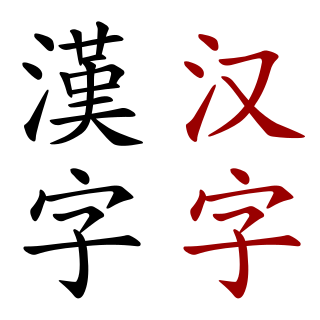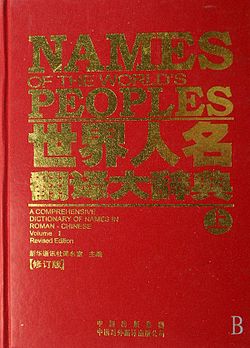
Chinese is a group of languages spoken natively by the ethnic Han Chinese majority and many minority ethnic groups in China. Approximately 1.35 billion people, or around 16% of the global population, speak a variety of Chinese as their first language.

Standard Chinese is a modern standard form of Mandarin Chinese that was first codified during the republican era (1912‒1949). It is designated as the official language of mainland China and a major language in the United Nations, Singapore, and Taiwan. It is largely based on the Beijing dialect. Standard Chinese is a pluricentric language with local standards in mainland China, Taiwan and Singapore that mainly differ in their lexicon. Hong Kong written Chinese, used for formal written communication in Hong Kong and Macau, is a form of Standard Chinese that is read aloud with the Cantonese reading of characters.

Taiwanese Hokkien, or simply Taiwanese, also known as Taiuanoe, Taigi, Taigu, Taiwanese Minnan, Hoklo and Holo, is a variety of the Hokkien language spoken natively by more than 70 percent of the population of Taiwan. It is spoken by a significant portion of those Taiwanese people who are descended from Hoklo immigrants of southern Fujian. It is one of the national languages of Taiwan.

Chinese characters are logographs used to write the Chinese languages and others from regions historically influenced by Chinese culture. Chinese characters have a documented history spanning over three millennia, representing one of the four independent inventions of writing accepted by scholars; of these, they comprise the only writing system continuously used since its invention. Over time, the function, style, and means of writing characters have evolved greatly. Informed by a long tradition of lexicography, modern states using Chinese characters have standardised their forms and pronunciations: broadly, simplified characters are used to write Chinese in mainland China, Singapore, and Malaysia, while traditional characters are used in Taiwan, Hong Kong, and Macau.
Sino-Japanese vocabulary, also known as kango, is a subset of Japanese vocabulary that originated in Chinese or was created from elements borrowed from Chinese. Some grammatical structures and sentence patterns can also be identified as Sino-Japanese.
Gairaigo is Japanese for "loan word", and indicates a transcription into Japanese. In particular, the word usually refers to a Japanese word of foreign origin that was not borrowed in ancient times from Old or Middle Chinese, but in modern times, primarily from English, Portuguese, Dutch, and modern Chinese dialects, such as Standard Chinese and Cantonese. These are primarily written in the katakana phonetic script, with a few older terms written in Chinese characters (kanji); the latter are known as ateji.
Phono-semantic matching (PSM) is the incorporation of a word into one language from another, often creating a neologism, where the word's non-native quality is hidden by replacing it with phonetically and semantically similar words or roots from the adopting language. Thus the approximate sound and meaning of the original expression in the source language are preserved, though the new expression in the target language may sound native.

Written Cantonese is the most complete written form of a Chinese language after that for Mandarin Chinese and Classical Chinese. Written Chinese was the main literary language of China until the 19th century. Written vernacular Chinese first appeared in the 17th century, and a written form of Mandarin became standard throughout China in the early 20th century. Cantonese is a common language in places like Hong Kong and Macau. While the Mandarin form can to some extent be read and spoken word for word in other Chinese varieties, its intelligibility to non-Mandarin speakers is poor to incomprehensible because of differences in idioms, grammar and usage. Modern Cantonese speakers have therefore developed new characters for words that do not exist and have retained others that have been lost in standard Chinese.

Taiwanese Mandarin, frequently referred to as Guoyu or Huayu, is the variety of Mandarin Chinese spoken in Taiwan. A large majority of the Taiwanese population is fluent in Mandarin, though many also speak a variety of Min Chinese known as Taiwanese Hokkien, commonly called Minnanyu, Southern Min, or Hokkien. This language has had a significant influence on Mandarin as spoken on the island.
Sino-Vietnamese vocabulary is a layer of about 3,000 monosyllabic morphemes of the Vietnamese language borrowed from Literary Chinese with consistent pronunciations based on Middle Chinese. Compounds using these morphemes are used extensively in cultural and technical vocabulary. Together with Sino-Korean and Sino-Japanese vocabularies, Sino-Vietnamese has been used in the reconstruction of the sound categories of Middle Chinese. Samuel Martin grouped the three together as "Sino-xenic". There is also an Old Sino-Vietnamese layer consisting of a few hundred words borrowed individually from Chinese in earlier periods. These words are treated by speakers as native words. More recent loans from southern varieties of Chinese, usually names of foodstuffs such as lạp xưởng 'Chinese sausage', are not treated as Sino-Vietnamese but more direct borrowings.

Transcription into Chinese characters is the use of traditional or simplified Chinese characters to phonetically transcribe the sound of terms and names of foreign words to the Chinese language. Transcription is distinct from translation into Chinese whereby the meaning of a foreign word is communicated in Chinese. Since English classes are now standard in most secondary schools, it is increasingly common to see foreign names and terms left in their original form in Chinese texts. However, for mass media and marketing within China and for non-European languages, particularly those of the Chinese minorities, transcription into characters remains very common.
Hong Kong Cantonese is a dialect of the Cantonese language of the Sino-Tibetan family.
Wasei-kango are those words in the Japanese language composed of Chinese morphemes but invented in Japan rather than borrowed from China. Such terms are generally written using kanji and read according to the on'yomi pronunciations of the characters. While many words belong to the shared Sino-Japanese vocabulary, some kango do not exist in Chinese while others have a substantially different meaning from Chinese; however some words have been borrowed back to Chinese.
Singaporean Mandarin is a variety of Mandarin Chinese spoken natively in Singapore. It is one of the four official languages of Singapore along with English, Malay and Tamil.

Hokkien is a variety of the Southern Min languages, native to and originating from the Minnan region, in the southeastern part of Fujian in southeastern mainland China. It is also referred to as Quanzhang, from the first characters of the urban centers of Quanzhou and Zhangzhou.
Differing literary and colloquial readings for certain Chinese characters are a common feature of many Chinese varieties, and the reading distinctions for these linguistic doublets often typify a dialect group. Literary readings are usually used in loanwords, names, literary works, and in formal settings, while colloquial/vernacular readings are usually used in everyday vernacular speech.
Standard Singaporean Mandarin is the standard form of Singaporean Mandarin. It is used in all official Chinese media, including all television programs on Channel 8 and Channel U, various radio stations, as well as in Chinese lessons in all Singapore government schools. The written form of Chinese used in Singapore is also based on this standard. Standard Singaporean Mandarin is also the register of Mandarin used by the Chinese elites of Singapore and is easily distinguishable from the Colloquial Singaporean Mandarin spoken by the general populace.
Hokkien, a Southern Min variety of Chinese spoken in Southeastern China, Taiwan and Southeast Asia, does not have a unitary standardized writing system, in comparison with the well-developed written forms of Cantonese and Vernacular Chinese (Mandarin). In Taiwan, a standard for Written Hokkien has been developed by the Republic of China Ministry of Education including its Dictionary of Frequently-Used Taiwan Minnan, but there are a wide variety of different methods of writing in Vernacular Hokkien. Nevertheless, vernacular works written in Hokkien are still commonly seen in literature, film, performing arts and music.
Hong Kong written Chinese (HKWC) is a local variety of written Chinese used in formal written communication in Hong Kong. The common Hongkongese name for this form of Chinese is "written language" (書面語), in contrast to the "spoken language" (口語), i.e. Cantonese. While, like other varieties of Written Chinese, it is largely based on Mandarin, it differs from the mainland’s national variety of Standard Chinese (Putonghua) in several aspects, for example that it is written in traditional characters, that its phonology is based on Cantonese, and that its lexicon has English and Cantonese influences. Thus it must not be confused with written Cantonese which, even in Hong Kong, enjoys much less prestige as a literary language than the "written language". The language situation in Hong Kong still reflects the pre-20th century situation of Chinese diglossia where the spoken and literary language differed and the latter was read aloud in the phonology of the respective regional variety instead of a national one.







